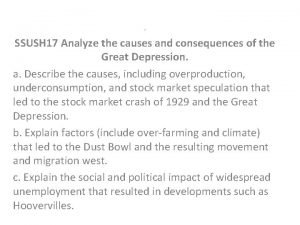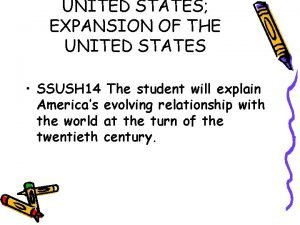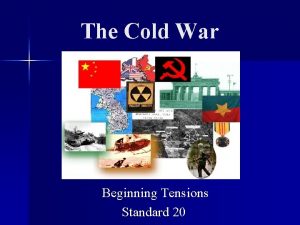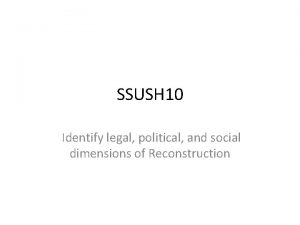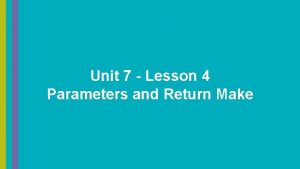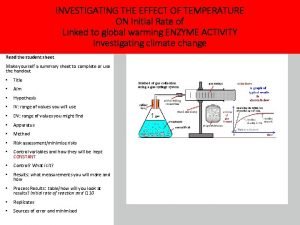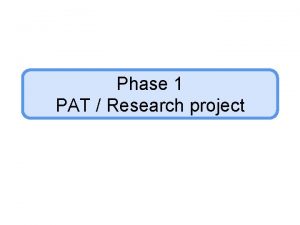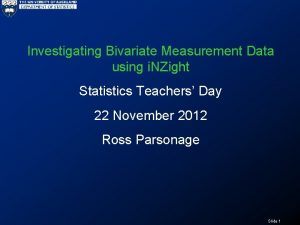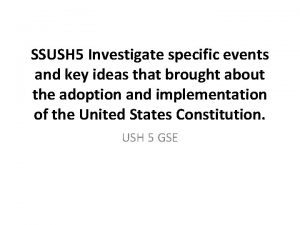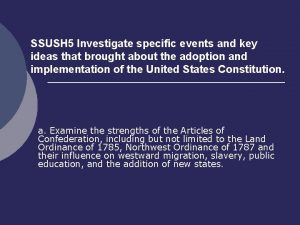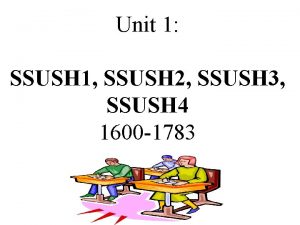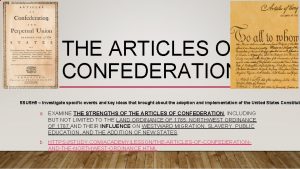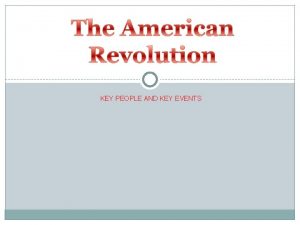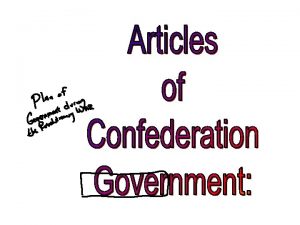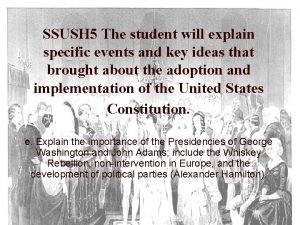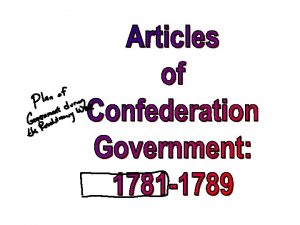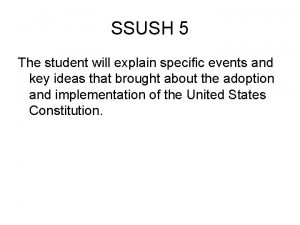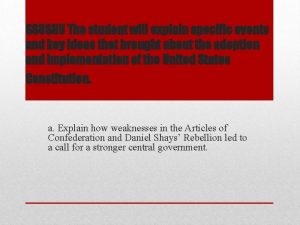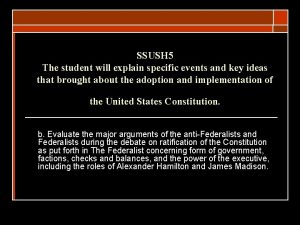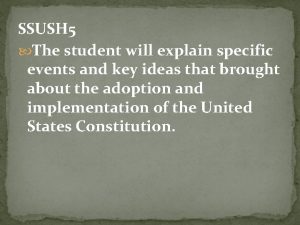SSUSH 5 Investigate specific events and key ideas















- Slides: 15

SSUSH 5 Investigate specific events and key ideas that brought about the adoption and implementation of the United States Constitution. a. Examine the strengths of the Articles of Confederation, including but not limited to the Land Ordinance of 1785, Northwest Ordinance of 1787 and their influence on westward migration, slavery, public education, and the addition of new states. b. Evaluate how weaknesses in the Articles of Confederation and Daniel Shays’ Rebellion led to a call for a stronger central government. c. Explain the key features of the Constitution, including the Great Compromise, limited government, and the Three-Fifths Compromise. d. Evaluate the major arguments of the Anti-Federalists and Federalists during the debate on ratification of the Constitution, The Federalist Papers, and the roles of Alexander Hamilton and James Madison. e. Explain how objections to the ratification of the Constitution were addressed in the Bill of Rights.

a. Examine the strengths of the Articles of Confederation, including but not limited to the Land Ordinance of 1785, Northwest Ordinance of 1787 and their influence on westward migration, slavery, public education, and the addition of new states. • The Northwest Ordinance (1785) was legislation that provided for the organization of the northwest territories of the United States (north of the Ohio River, east of the Mississippi). • By establishing a procedure to subdivide the territory and survey for townships, the Northwest Ordinance encouraged the continued westward migration of Americans. The sale of these lands by the government was a primary source of revenue in the era of the early republic. • Slavery was banned in the northwest territories under the Ordinance, an early example of the divisions developing between the “free” north and the slave South. • The Northwest Ordinance included a provision to promote public education- each township surveyed included a section of land, the income from which was intended for public education. • The Northwest Ordinance also established terms for the admission of new states- settlers could organize a territorial government when the population reached 5, 000, then apply for statehood after a population of 60, 000 had been reached.



5. b- Evaluate how weaknesses in the Articles of Confederation and Daniel Shays’ Rebellion led to a call for a stronger central government. • • • The Articles of Confederation was the first constitutional government of the United States. It was formed in the midst of the Revolution, (proposed in 1777, and formally adopted in 1781. ) The Articles created a “confederation” style government, which means that the constituent states were essentially sovereign and independent. The designers of the Articles purposefully established a weak national authority, because they believed that most matters were best left to the governments of each state. The national government, under the articles, consisted of a single branch- a unicameral Congress, and would only handle matters that affected the 13 states as a whole- national defense, diplomacy with foreign nations, etc. Through the 1780 s, however, the weaknesses of the Articles began to seriously hamper the effectiveness of the national government. Three detrimental weakness came to produce serious problems for the young nation, 1) Congress under the articles had no power to tax, and 2) no power to regulate trade between the states 3) amending the Articles required unanimous consent

• • • Shays’ Rebellion and interstate commerce In 1786, an event in western Massachusetts put the weaknesses of the national government under the Articles into sharp relief. Daniel Shays was an army captain during the Revolutionary War. Like many veterans, Shays ran into hard times in the post-Revolution years of inflation, and a corresponding lack of currency. When the Massachusetts government refused to print more paper money and lenders began foreclosing on farmsteads for non-payment, Shays gathered a group of farmers who took up arms and led a full-scale rebellion. Fearing that the unrest might spread, leaders from various states began to take seriously the idea of altering the Articles to address the fact that the nation lacked a stable continental currency and that the National Congress had no way of raising revenue through taxation. Other events around the same time also convinced various state leaders to address amendments to the Articles. Many states had developed prohibitive trade regulations against other states to try and strengthen their own economies. The effect was contentious inter-state relations, and economic inefficiency in national trade as a whole. Leaders from several states met in 1785 and 1786 to discuss the problem of interstate trade. These ongoing issues, with the addition of Shays Rebellion, convinced all but Rhode Island to elect delegates to attend yet another meeting in 1787. The meeting was held in Philadelphia, and shortly after it began the 55 delegates in attendance agreed that simply revising the Articles would not be enough. Rather, an entirely new constitution needed to be drafted. The Philadelphia Convention then turned into the Constitutional Convention.

5. c- Explain the key features of the Constitution, including the Great Compromise, limited government, and the Three-Fifths Compromise . • Once the delegates (now known as the “Framers”) gathered at Philadelphia determined to scrap the Articles and draft a new Constitution, they had to decide how the new government would be structured, and how much power would be given to the national government. • Several key decisions and compromises were made between the delegates of the 13 states. • The idea of “limited government” was an important consideration of the Framers as well. Simply put, this is the idea that government is not all powerful, and that no one, not even the government itself, is above the rule of law established in the Constitution. A related concept is that of “popular sovereignty, ” meaning that under our Constitution, the people hold the ultimate authority of government. The first three words of the Preamble to the Constitution, “We the people, ” indicates this principle.

Great Compromise • One of the most important compromises achieved at the Constitutional Convention, later known as the “Great Compromise” (also sometimes referred to as the Connecticut Compromise) had to do with how the states would be represented in the national government. • There was a fear, especially among smaller states, that they would have too little say in the newly formed Congress, when compared to the larger states. A solution was reached by creating a bicameral Congress, where the membership of one house would be determined by population (House of Representatives), while in the other house (Senate) states would be represented equally. • A state’s population determines how many members it has in the House of Representatives. States with large populations have more members in the House. For example, California, the most populous state, has 53. Georgia has 14 House members, and a state like Wyoming, the least populous state in the union, only gets one. In the Senate, all states, regardless of size, have two Senators.

Separation of Powers • The Framers also agreed to create a government based on the principle of separation of powers. To activate this principle (inspired in part by the French political philosopher Montesquieu) the Framers created three separate and independent branches of government- legislative, executive and judicial. • Furthermore, the Framers devised a system of “checks and balances, ” so that no one branch could exercise too much power independently. One example of checks and balances is the process of nominating federal judges. The president nominates judges, but the Senate must approve that choice. The legislative branch (Senate) can “check and balance” the power of the executive branch (president) to nominate judges serving in the judicial branch.

Limited Government • The idea of “limited government” was an important consideration of the Framers as well. Simply put, this is the idea that government is not all powerful, and that no one, not even the government itself , is above the rule of law established in the Constitution. A related concept is that of “popular sovereignty, ” meaning that under our Constitution, the people hold the ultimate authority of government. The first three words of the Preamble to the Constitution, “We the people, ” indicates this principle. • The idea of limited government in the Anglo-American tradition goes back to 1215, when King John of England signed the Magna Carta, agreeing to abide by certain limitations in the exercise of his power.

The Constitution and Slavery • Another major compromise reached at the 1787 Constitutional Convention dealt with the divisive issue of slavery. Some delegates from northern states, all of which had abolished slavery by that point, argued that the slave populations in the South should not be counted for representation in the federal Congress. The southern states thought they should and a compromise was reached to count 3 out of every 5 slaves for representation and taxation purposes. This is known as the 3/5 Compromise. • Interestingly, the words slavery or slave never appear in the Constitution. Instead, in the clause establishing the 3/5 provision, slave populations are referred to as “other persons. ” • The Framers also reached a compromise to place a 20 year moratorium on any laws that would prohibit the slave trade. When the moratorium was satisfied in 1809, Congress passed laws that banned the foreign slave trade, but left the domestic trade intact where it existed.

d. Evaluate the major arguments of the Anti-Federalists and Federalists during the debate on ratification of the Constitution, The Federalist Papers, and the roles of Alexander Hamilton and James Madison. • Once the Constitution was finished, it was sent to the 13 state legislatures to be ratified. 9 of the 13 states had to ratify the new Constitution for it to take effect. • As the document made its way through the various state houses and among the public, a great debate emerged about whether to support ratification. Two sides emerged: The Federalists supported ratification, while the Anti-Federalists did not. • The Federalists, led by Alexander Hamilton, James Madison, and others, supported the Constitution because they believed that for the United States to be truly “united, ” the central (national) government must be given more power- as the Constitution did by allowing the federal government to tax, regulate trade, and enforce its laws with a powerful chief executive (president). • The Anti-Federalists, led by old-school Patriots like Patrick Henry, were opposed the Constitution because they thought the government it created was too powerful. They believed that most powers of government should reside with the states.

Federalist Papers • The Federalist Papers were a series of 89 essays written by leading Federalists Madison, Hamilton, and John Jay. They were intended to convince (especially) New York to ratify the Constitution. • In these essays, the authors made a forceful and eloquent case for ratification, extolling the numerous advantages of the republican form of federal government created by the Constitution, as well as the virtues of a strong executive. • The Anti-Federalists continued to argue that the government created by the Constitution was too powerful and might lead to tyranny. They insisted that a Bill of Rights be amended to the Constitution, and its guarantee proved to be the last major hurdle to get the Constitution ratified, which it finally was on 17 September 1789.

5. e- Explain how objections to the ratification of the Constitution were addressed in the Bill of Rights. • The Bill of Rights, the first ten amendments to the Constitution, were ratified in 1791. Whereas the original Constitution consists almost solely of how the government CAN exercise its power, the Bill of Rights are mostly guarantees of what the government CANNOT do to the states and their citizens. • The Bill of Rights protects the rights of citizens to free speech, religious freedom, free assembly, protections from government search and seizure, protections and rights for people accused of crimes, protections from cruel punishments, and provisions that any powers not given to the national government are “reserved” for the states.

• • • • • Amendment I Congress shall make no law respecting an establishment of religion, or prohibiting the free exercise thereof; or abridging the freedom of speech, or of the press; or the right of the people peaceably to assemble, and to petition the government for a redress of grievances. Amendment II A well regulated militia, being necessary to the security of a free state, the right of the people to keep and bear arms, shall not be infringed. Amendment III No soldier shall, in time of peace be quartered in any house, without the consent of the owner, nor in time of war, but in a manner to be prescribed by law. Amendment IV The right of the people to be secure in their persons, houses, papers, and effects, against unreasonable searches and seizures, shall not be violated, and no warrants shall issue, but upon probable cause, supported by oath or affirmation, and particularly describing the place to be searched, and the persons or things to be seized. Amendment V No person shall be held to answer for a capital, or otherwise infamous crime, unless on a presentment or indictment of a grand jury, except in cases arising in the land or naval forces, or in the militia, when in actual service in time of war or public danger; nor shall any person be subject for the same offense to be twice put in jeopardy of life or limb; nor shall be compelled in any criminal case to be a witness against himself, nor be deprived of life, liberty, or property, without due process of law; nor shall private property be taken for public use, without just compensation. Amendment VI In all criminal prosecutions, the accused shall enjoy the right to a speedy and public trial, by an impartial jury of the state and district wherein the crime shall have been committed, which district shall have been previously ascertained by law, and to be informed of the nature and cause of the accusation; to be confronted with the witnesses against him; to have compulsory process for obtaining witnesses in his favor, and to have the assistance of counsel for his defense. Amendment VII In suits at common law, where the value in controversy shall exceed twenty dollars, the right of trial by jury shall be preserved, and no fact tried by a jury, shall be otherwise reexamined in any court of the United States, than according to the rules of the common law. Amendment VIII Excessive bail shall not be required, nor excessive fines imposed, nor cruel and unusual punishments inflicted. Amendment IX The enumeration in the Constitution, of certain rights, shall not be construed to deny or disparage others retained by the people. Amendment X The powers not delegated to the United States by the Constitution, nor prohibited by it to the states, are reserved to the states respectively, or to the people.
 Ssush
Ssush Ssush
Ssush Ssush
Ssush Ssush
Ssush Ssush
Ssush Vertical integration
Vertical integration King of england during revolutionary war
King of england during revolutionary war Lesson 4: parameters and return make
Lesson 4: parameters and return make Priest in oedipus rex
Priest in oedipus rex Investigate a factor affecting the initial rate of reaction
Investigate a factor affecting the initial rate of reaction How to investigate a problem
How to investigate a problem Nzight
Nzight Investigate reflection
Investigate reflection Mutually exclusive vs non mutually exclusive
Mutually exclusive vs non mutually exclusive Glycerol specific gravity
Glycerol specific gravity Specific volume to specific gravity
Specific volume to specific gravity
